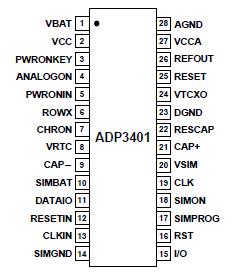ADP3401: Features: ·Handles all GSM Baseband Power Management Functions·Four LDOs Optimized for Specific GSM Subsystems·Charges Li-Mn Coin Cell for Real-Time Clock·Charge Pump and Logic Level Translators for...
floor Price/Ceiling Price
- Part Number:
- ADP3401
- Supply Ability:
- 5000
Price Break
- Qty
- 1~5000
- Unit Price
- Negotiable
- Processing time
- 15 Days
SeekIC Buyer Protection PLUS - newly updated for 2013!
- Escrow Protection.
- Guaranteed refunds.
- Secure payments.
- Learn more >>
Month Sales
268 Transactions
Payment Methods
All payment methods are secure and covered by SeekIC Buyer Protection PLUS.

 ADP3401 Data Sheet
ADP3401 Data Sheet








